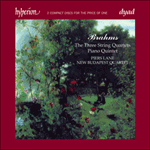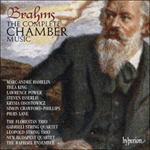
Welcome to Hyperion Records, an independent British classical label devoted to presenting high-quality recordings of music of all styles and from all periods from the twelfth century to the twenty-first.
Hyperion offers both CDs, and downloads in a number of formats. The site is also available in several languages.
Please use the dropdown buttons to set your preferred options, or use the checkbox to accept the defaults.

| New Budapest Quartet» More |
Whether or not Brahms was consciously aware of it, the theme of the slow movement is essentially an inverted form of the opening Allegro’s second subject. The sonority in which the theme is first heard is of a leanness that might have appealed to Haydn. It has the melody entrusted to the first violin, while viola and cello accompany with a smoothly flowing line moving in parallel octaves. Following this two-stranded texture, the full quartet sound emerges only gradually. For his contrasting middle section Brahms again takes a leaf out of Schubert’s book, and writes a dramatic, agitated passage in the minor. But the outburst is short-lived, before the emergence of a resigned, warmly lyrical theme in the major. It is this new theme that will later be used to bring the piece to a gentle conclusion—but not before Brahms has presented a full-scale reprise of the opening theme in the ‘wrong’ key of F major. The false reprise, if such it is, is perhaps Brahms’s compensation for the fact that all four of the quartet’s movements are in the same tonality of A.
For his third movement, Brahms makes a nostalgic return to the world of the eighteenth-century minuet. But this is no straightforward minuet, and in place of a trio it has a delicate scherzo-like passage in a quicker tempo. It is, then, a dual-purpose piece of a kind more often found in Brahms’s three-movement works, where the centrepiece can function as slow movement and scherzo rolled into one—as it does in the Violin Sonata in A major Op 100 and the String Quintet in F major Op 88. In the A minor String Quartet the integration between the two opposing types of material is particularly subtle: the scherzo-like passage is briefly interrupted by a return to the tempo of the minuet—once again in the ‘wrong’ key; but rather than invoke the minuet’s actual theme, the intervention is based on the melodic outline of the scherzo.
The finale derives much of its tension from a metrical conflict between theme and accompaniment. The main subject gives the impression of being largely in duple metre, while its emphatic chordal accompaniment is in a firm triple time. The phrases of the theme’s second half, moreover, divide the 3/4 bar into two equal halves of one-and-half beats, so that the accompaniment, remaining very much on the beat, sounds more dislocated than ever. The conflict is resolved towards the end of the piece, where the theme is transmuted into a gentle, albeit syncopated, waltz in the major. But in the end Brahms will have none of such whimsy, and the music turns back to the minor, and hurtles inexorably towards an accelerated conclusion.
from notes by Misha Donat © 2007
Que Brahms en fût ou non conscient, le thème du mouvement lent est fondamentalement une forme renversée du second sujet de l’Allegro initial. La sonorité dans laquelle ce thème apparaît pour la première fois est d’une ténuité qui n’aurait peut-être pas déplu à Haydn. La mélodie est confiée au premier violon, tandis que l’alto et le violoncelle l’accompagnent avec une ligne au flux régulier évoluant en octaves parallèles. Suivant cette texture à deux brins, le plein son du quatuor émerge seulement à petits pas. Pour sa section centrale contrastée, Brahms prend encore modèle sur Schubert pour écrire un passage dramatique, agité, en mineur. Mais cette explosion ne fait pas long feu et un thème émerge bientôt, résigné, chaleureusement lyrique, en majeur. C’est ce nouveau thème qui servira à conclure la pièce en douceur—mais pas avant que Brahms ait présenté une reprise à grande échelle du thème d’ouverture dans la «fausse» tonalité de fa majeur. Cette fausse reprise, si c’est bien ce qu’elle est, est peut-être pour lui une manière de compenser le fait que chacun des quatre mouvements de son quatuor est dans la même tonalité.
Pour son troisième mouvement, Brahms fait un retour nostalgique au menuet du XVIIIe siècle. Mais ce n’est pas là un menuet simple, car le trio est remplacé par un délicat passage en manière de scherzo, dans un tempo accéléré. C’est, alors, une pièce à double fonction, de celles qu’on rencontre surtout dans les œuvres brahmsiennes en trois mouvements, où la partie centrale peut fonctionner comme un mouvement lent et un scherzo roulés en un—à l’image de ce qui se passe dans la Sonate pour violon en la majeur, op. 100 et dans le Quintette à cordes en fa majeur, op. 88. Dans le présent quatuor, l’intégration entre les deux types de matériau opposés est particulièrement subtile: le passage en manière de scherzo est brièvement interrompu par un retour au tempo du menuet (de nouveau dans la fausse tonalité); mais plutôt que d’évoquer le thème du menuet, l’intervention repose sur le contour mélodique du scherzo.
Le finale tire l’essentiel de sa tension d’un conflit métrique entre le thème et l’accompagnement. Le sujet principal donne l’impression d’être largement en mètre binaire, tandis que son vigoureux accompagnement en accords est dans une solide mesure ternaire. Au surplus, les phrases de la seconde moitié du thème scindent la mesure à 3/4 en deux portions égales d’un temps et demi, si bien que l’accompagnement, qui reste essentiellement sur le temps, semble plus disloqué que jamais. Ce conflit est résolu vers la fin, quand le thème est transmué en une valse douce, quoique syncopée, en majeur. Mais Brahms finit par cesser ce genre de foucades: la musique revient au mineur et file inexorablement, à tombeau ouvert, vers une conclusion accélérée.
extrait des notes rédigées par Misha Donat © 2007
Français: Hypérion
Unabhängig davon, ob sich nun Brahms der Tatsache bewusst war oder nicht, erweist sich das Thema des langsamen Satzes im Wesentlichen als eine umgekehrte Form des zweiten Themas aus dem einleitenden Allegro. Der Klang beim ersten Auftritt des Themas ist so schlank, dass er Haydn gefallen hätte. Die Themenmelodie wird der ersten Violine anvertraut, während die Bratsche und das Violoncello mit einer geschmeidig fließenden, sich in Oktavparallelen bewegenden Linie begleiten. Nach dieser zweigleisigen Textur schält sich der volle Quartettklang nur allmählich heraus. Für seinen kontrastierenden Mittelteil nimmt Brahms wieder bei Schubert Anleihe und schreibt eine dramatische, aufgeregte Passage in Moll. Aber der Ausbruch ist nur kurzlebig. Ihm schließt sich ein ergebenes, warm lyrisches Thema in Dur an. Dieses neue Thema wird später herangezogen, um das Werk zu einem sanften Abschluss zu bringen—das geschieht aber erst, nachdem Brahms eine vollständige Reprise des Anfangsthemas in der „falschen“ Tonart F-Dur abgewickelt hat. Die falsche Reprise, falls man sie überhaupt so bezeichnen kann, ist womöglich Brahms’ Ausgleich für den Umstand, dass alle vier Quartsätze in der gleichen Tonart, A-Dur, stehen.
Für seinen dritten Satz kehrt Brahms nostalgisch zurück zur Welt des Menuetts im 18. Jahrhundert. Das ist allerdings kein gewöhnliches Menuett, und anstelle eines Trios erklingt eine delikate scherzoartige Passage in einem schnelleren Tempo. Es ist also ein Mehrzweckstück von der Art, die man häufiger in Brahms’ dreisätzigen Werken findet, wo der Mittelsatz sowohl die Funktion eines langsamen Satzes als auch eines Scherzos übernehmen kann—wie zum Beispiel in der Violinsonate in A-Dur op. 100 und im Streichquintett in F-Dur op. 88. Im a-Moll-Streichquartett ist die Integration zwischen den zwei gegensätzlichen Materialtypen besonders geschickt: die scherzoartige Passage wird kurz von einer Rückkehr zum Menuetttempo unterbrochen—wiederum in der „falschen“ Tonart. Anstatt aber das eigentliche Menuettthema zu beschwören, beruht die Unterbrechung auf den melodischen Grundzügen des Scherzos.
Der Schlusssatz gewinnt den Großteil seiner Spannung aus dem metrischen Konflikt zwischen Thema und Begleitung. Das Hauptthema hinterlässt den Eindruck, als herrsche hier hauptsächlich ein Zweiertakt, während seine emphatische Akkordbegleitung in einem strengen Dreiertakt steht. Die musikalischen Phrasen der zweiten Themenhälfte unterteilen zudem den 3/4-Takt in zwei gleiche Hälften aus eineinhalb Schlägen, so dass die Begleitung, die sich sehr stark an den Schlag hält, noch deplatzierter als zuvor klingt. Der Konflikt wird gegen Ende des Stückes gelöst, wo das Thema eine Verwandlung in einen sanften, wenn auch synkopierten Walzer in Dur erfährt. Aber am Schluss mag Brahms solche Launenhaftigkeit nicht, und die Musik kehrt nach Moll zurück, wo sie unerbittlich einem beschleunigten Ausklang entgegenrast.
aus dem Begleittext von Misha Donat © 2007
Deutsch: Elke Hockings
 Brahms: String Quartets & Piano Quintet Brahms: String Quartets & Piano Quintet‘Highly recommendable … Brahms is fortunate here’ (Gramophone) ‘The New Budapest are outstanding for the mellow warmth and refinement of their corporate sound. Hyperion's distinguished new issue was needed … ...» More |
 Brahms: The Complete Chamber Music Brahms: The Complete Chamber Music‘The pick of this crop has to be Brahms's Complete Chamber Music from Hyperion. Spanning more than two decades, this box contains the finest, mainly B ... ‘Immerse yourself in this set of 12 CDs of Brahms's chamber music … in the last 25 years, Hyperion has managed to persuade some of the finest of ...» More |

